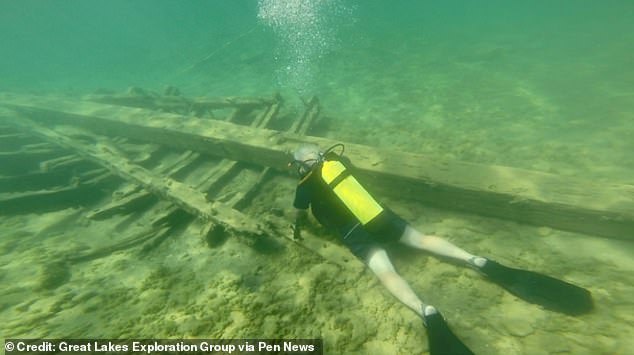70-Year-Old Michigan Explorer Claims He Discovered 1679 Shipwreck That’s the ‘Holy Grail’… And Claims Petty Officials Won’t Let Him Dig It Up

A Michigan shipwreck hunter claims he has found the remains of a ghost ship that disappeared in 1679, but he says officials are standing in the way of finding his sunken treasure.
Steve Libert, 70, believes he has discovered the wreck of Le Griffin in Lake Michigan, the first full-size European ship to sail in the Upper Great Lakes.
The retired naval intelligence officer has been searching for the legendary ship for 43 years, but his recent claim to have found the vessel has been dismissed by skeptical archaeologists and historians.
He recently swam past a heavy beam with moss-covered protruding ribs. He believes the structure has certain features that match the lost ship, including wrought-iron fasteners and wooden pins.

A Michigan shipwreck hunter is convinced he has found the remains of a ghost ship that disappeared in 1679, but he claims his efforts to dig it up are being thwarted by petty state officials
“The Griffin has not been found,” Wayne R. Lusardi, a maritime archaeologist for the Michigan Department of Natural Resources, told the Wall Street Journal.
He described the 70-year-old’s discovery as “fantasy”.
But Libert said the evidence is right in front of them.
“They don’t look at the evidence,” he argued. “They think I’m a shady character.”
Valerie van Hees, director of the Michigan Shipwreck Association, was also not convinced.
“From the 1930s until now there have been several ‘discoveries’ of the Griffon,” Van Hees said skeptically.
The legendary ship was once called the “Holy Grail” for shipwreck hunters exploring the depths of the American Great Lakes.

Steve Libert, 70, believes he has discovered the wreck of Le Griffin, the first full-size European ship to sail in the Upper Great Lakes

The ship was once called the “holy grail” for shipwreck hunters exploring the depths of the American Great Lakes
It was built by the French explorer René Robert Cavelier, Sieur de La Salle, with the aim of finding a route through the lakes to China and Japan.
But the ship disappeared while carrying a valuable cargo of furs, and was rumored to have been cursed by an Iroquois prophet.
“It’s the first real shipwreck on the Great Lakes, and it’s a great mystery,” Bruce Lynn, director of the Great Lakes Shipwreck Museum, told the Wall Street Journal.
In 2001, after losing a lengthy legal battle with the state of Michigan over another sunken ship, Libert was diving into murky waters in search of Le Griffon when he struck something and his mask fell off.
He soon became convinced that he had inadvertently discovered part of a ship. Images revealing a large mass on the bottom of the lake seemed to confirm his theory.

Libert was still able to find a pole, which French archaeologists believe shows several features of a bowsprit – the long pole that protrudes from the front of a ship

Libert filed a request with the state for a permit to dig, but was again denied, throwing his plans into disarray
Libert filed a request with the state for a permit to excavate, but the state again denied, jeopardizing his plans.
This time, however, he appealed to the French nation to claim the wreck as its own, legal property, a ploy that worked temporarily.
By 2013, Libert had won his legal battle and an expedition was launched to investigate the findings. But the location was misleading. It wasn’t Le Griffon. It was a 4-foot-high mountain of zebra mussels.
Despite this painful setback, Libert managed to recover a pole. According to French archaeologists, this pole shows some characteristics of a bowsprit: the long pole that sticks out of the front of a ship.

“What I suspected was a ship was confirmed by me during a dive in September 2018,” he said
Carbon dating indicated that the object was found sometime between 1670 and 1950, but the Michigan History Center dismissed the find as a commercial fishing pole, used sometime between the mid-19th and mid-20th centuries.
Libert rejected this conclusion, arguing that a stake must have a pointed end, not a beveled end as the object in question had.
In 2014, Libert was studying satellite imagery and spotted a huge trident shape in the waters of Lake Michigan that he suspected might be part of a ship. Four years later, he checked the location and determined it was the Griffon.
“I suspected it was a ship, and I confirmed it during a dive in September 2018,” he said.
But the state of Michigan quickly stepped in and put a stop to all excavation plans.

In 2014, Libert was studying satellite images and noticed a huge trident shape in the waters of Lake Michigan, which he suspected might be part of a ship
“The state believes that we are infringing on their sovereignty and that we are nothing more than treasure hunters who are infringing on the rights of academia and archaeologists.”
He first became interested in the missing ship at age 14 when his eighth-grade teacher told the class about it. According to de Libert, his teacher touched his shoulder and said, “Maybe someone in this class will find it someday.”
Now he wants permission to excavate a group of rocks that he thinks could be ballast stones hiding the Griffon’s guns. But he told the Wall Street Journal that the years of back-and-forth talks with the state have made him tired.
“I’m 70 years old and not in the best of health,” Libert noted. “I don’t want to have to wait another 10 years to get a new license — even if I could get one.”




